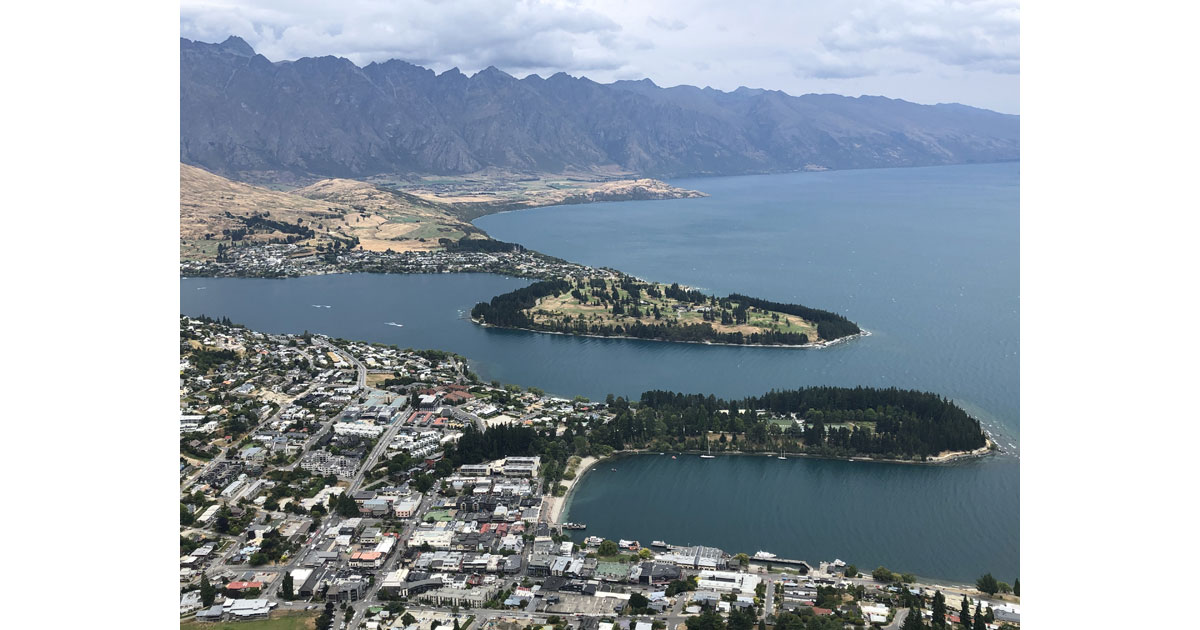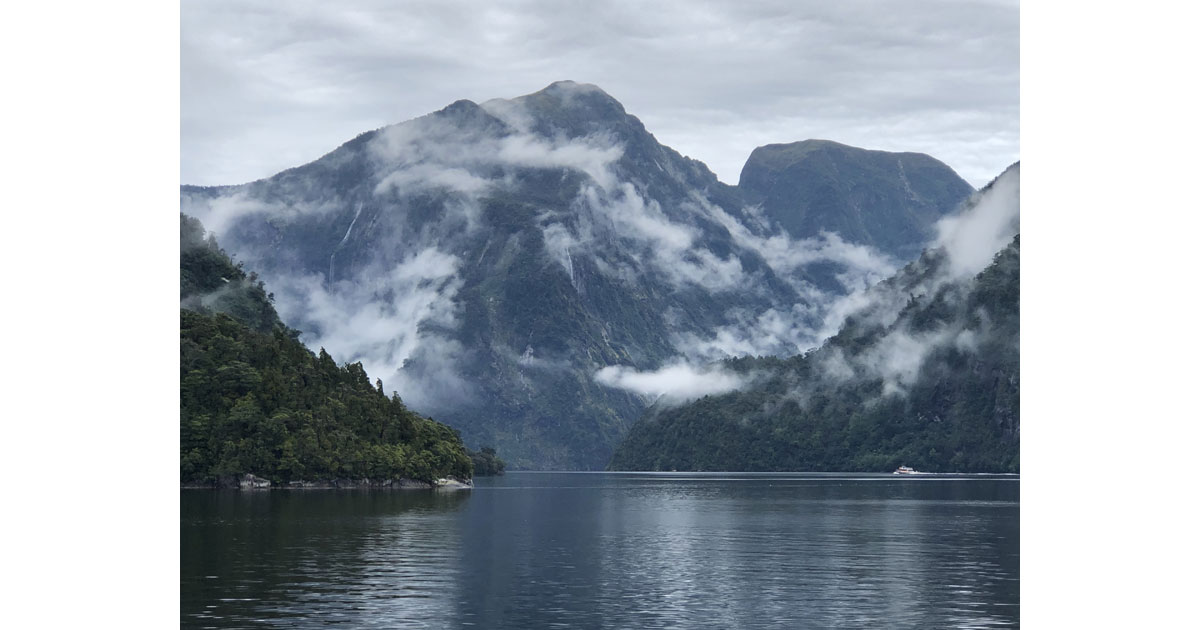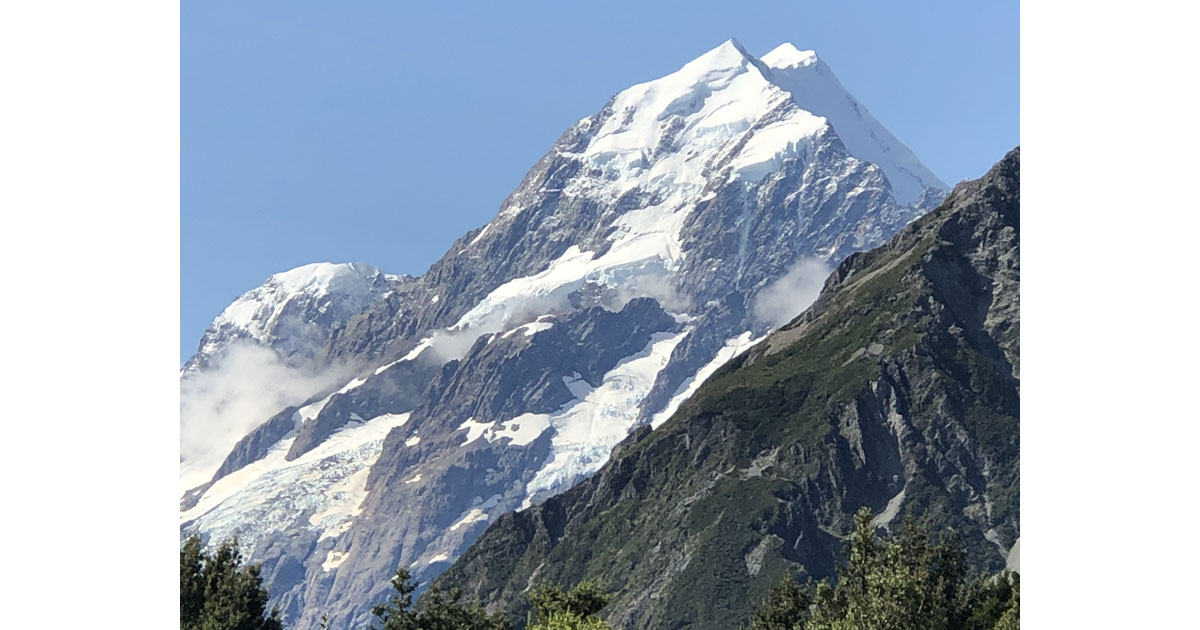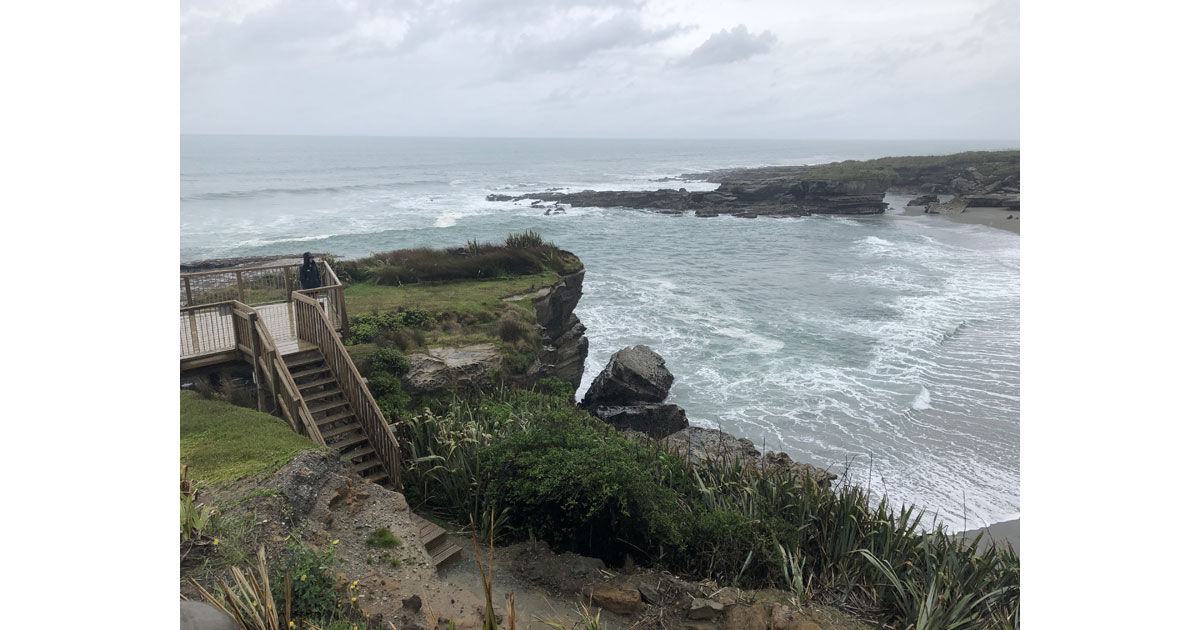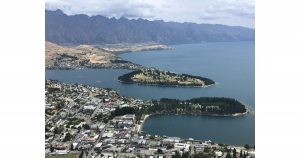DISCOVER A HIKER’S PARADISE ON NEW ZEALAND’S SOUTH ISLAND – PART 3
by Debbie Stone
 BIG BLEND RADIO: Debbie Stone discusses her adventures exploring New Zealand’s South Island. Listen / download the podcast on YouTube.com, BlogTalkRadio.com, Soundcloud or Spreaker.com.
BIG BLEND RADIO: Debbie Stone discusses her adventures exploring New Zealand’s South Island. Listen / download the podcast on YouTube.com, BlogTalkRadio.com, Soundcloud or Spreaker.com.
An unprecedented amount of rain and road washouts caused us to abort the highly anticipated Milford Sound cruise in Fiordland National Park. Fortunately, however, we were still able to explore the park via a boat ride through Doubtful Sound. Lesser known and less visited, due to being more remote than its more famous sister Milford, Doubtful Sound is arguably by many to be equally as dramatic. Though I confess, its name is a bit off-putting!
Story has it that when Captain James Cook got close to the entrance of the sound back in 1770, he decided to call the place, “Doubtful Harbor.” He feared he would not be able to sail his ship back out and thus resisted entering the inlet and instead continued on around the island.
Also of interest to note is that technically, as a post-glacier valley flooded by the sea, this is a fjord, not a sound. But, when early sealers and whalers came, they renamed Cook’s harbor Doubtful Sound and it stuck.
Doubtful Sound is a secluded, vast wonderland, which teems with wildlife. It contains one of the ten marine reserves in Fiordland National Park, which is listed as a UNESCO World Heritage Site. At three million acres, Fiordland is the largest of the national parks in New Zealand. It is also one of the wettest spots in the country, averaging over 200 days of rain a year.
To reach Doubtful Sound takes some effort. It involves a short boat trip across Lake Manapouri, followed by a bus ride over epic Wilmot Pass through Fiordland’s rainforest and finally into the Sound, where your cruise vessel awaits.
The cruise exceeded expectations, as the pristine wilderness scenery was striking. In the beginning, the clouds hung low and there was a magical, mystical quality to the atmosphere. Countless waterfalls cascaded from towering granite giants that cast their reflection in the water. And numerous small, uninhabited islands in the sea created an aura of brooding desolation. But then, bits of blue sky began to appear and the peaks started to reveal themselves in all their glory. As we plied the waterways, we spotted fur seals and their pups basking on the rocks and even had a pod of dolphins playfully swim around our boat. Throughout the trip, an onboard naturalist provided informative and entertaining commentary.
Within Fiordland are several Great Walks; one of which is the Kepler Track. This multi-day trek was carefully planned to show walkers all the best features of Fiordland, from its moss-draped beech forests and huge mountain ranges to its glacier-carved valleys, river flats, and limestone formations. We hiked two separate sections of this trail. One of the days it was dripping wet, and although hiking in the rain is not my first choice, I must admit it gave the forest a moody essence that had its own special beauty.
The trip’s itinerary allowed for one completely free day, which was in Queenstown. The break, which came a little over halfway through our journey, was welcome. For many, it provided a chance to catch up on laundry and sleep, but for others, such as myself, this was not an easy place to completely wind down due to the many exciting distractions.
The self-styled “adventure capital of New Zealand” and birthplace of bungy jumping, Queenstown is a heart-pumping playground. In addition to throwing yourself off a bridge, you can do every imaginable adrenaline-inducing activity you can think of, including paragliding, ziplining, jet boating, whitewater rafting, skydiving, luging and more. Or take it down a notch and go fishing, cruise Lake Wakatipu on an historic steamship and visit a sheep farm. Make sure to hop on the Skyline Gondola for fantastic views of the surrounding cinematic backdrop of mountains and lakes.
This tiny resort town also has a cosmopolitan dining scene with plenty of restaurants, cafes, and watering holes. And for those who want to do some retail therapy, there are stores and boutiques galore. Stroll along the colorful waterfront, as well as through the lovely botanic garden, and take a tour of the Kiwi Birdlife Park. The latter is home to over twenty species of native birds and reptiles; each a part of a managed conservation program. And if you want to see a real kiwi, this is the place.
Kiwi are flightless, tailless, long-beaked, nocturnal birds, that are rarely seen and highly-protected. A Maori legend is oft-used to explain how the kiwi lost its wings. According to the myth, the god of the forest, Tanemahuta, was concerned about his children, the trees, because the bugs and birds were eating away at them. He consulted his brother, Tane-hokahoka, god of the birds, who asked his children to come down from the forest roof and live on the floor. All the birds refused, citing various excuses. Only the kiwi agreed to sacrifice its wings to live on the forest floor. As a reward, Tane-hokahoka made him the most well-known and best-loved bird of all, which is why the kiwi is New Zealand’s national sweetheart.
At the Birdlife Park, the clock is reversed so visitors can see, by day, these interesting birds in a naturalistic night-time setting. Specialized lighting effects and infra-red cameras let you observe the kiwis foraging, grooming and going about their nightly activities. And for all things kiwi, attend the Kiwi Encounter, where one of the keepers will entertain you with a host of interesting facts about these weird and wonderful birds.
You’ll find as you travel around the country, that Kiwis, the name also used to call New Zealanders, are crazy about their birds. At times, I felt I was on an Audubon tour, as the guides pointed out each bird with particular reverence, from the Kia and the Tui to the Kiteru and the Kereru. Sometimes they were difficult to spot, as they blended in so well with the environment.
Birds get star-studded treatment because there’s just not that many animals in the country. These islands are so far from any other landmass that most creatures found everywhere else don’t exist here. For instance, most mammals. There are no native land mammals in New Zealand except for the Lesser Short-tailed Bat. But, there are other species that have been introduced over time. Unfortunately, a number of these creatures have wreaked havoc on the ecosystems, leading to the decline in population of various native birds. To combat this problem, the nation announced a plan to eradicate, in particular, all invasive rats, short-tailed weasels and possums by 2050.
Accommodations during the trip ranged from basic to upscale, depending on location. In some places, it’s just not possible to find top-notch properties, as you’re in the middle of nowhere and the choices are limited. But, on a trip like this, you don’t spend much time in your room. At the end of the day, you really just need the creature comforts of a decent bed and a hot shower. Some of the properties of note, either for their facilities, amenities, or dramatic settings, included the White Morph, Punakaiki Resort, Rainforest Retreat, Lake Ohau Lodge, and the Crowne Plaza.
When it came to food, there was no shortage of good meals. Astrid and Pim were masters at putting together delectable picnic lunches with spreads that included such fare as smoked salmon, salads, fresh veggies, quiche, cheeses, fruits, hearty breads, hummus and a host of other interesting dips.
Most of the dinners were in restaurants, where we were able to choose from the menu, though a few of the meals were prepared by our guides. This gave Astrid and Pim the opportunity to show off their culinary talents and mastery of the grill.
Being a pescatarian, I was delighted with all the fish options, including South Island salmon, crayfish, green-lipped mussels, gurnard, snapper, sand flounder, and of course, the proverbial fish and chips, and seafood chowder. For carnivores, New Zealand lamb and venison reign supreme.
I also became quite the fan of pies, a New Zealand staple that’s regarded as ready-made “cabinet food.” These are the savory kind of pies, stuffed with meat and/or veggies and cheese, which you can take away for an easy-to-eat snack or light meal.
I never, however, acquired a taste for either Marmite or Vegemite, the yeast-based spreads that hail from Britain and Australia. Many Kiwis are fond of either or both, and use them in sandwiches and atop crackers and toast. In my opinion, the spreads have an off-putting smell and their salty and bitter taste is unappealing. Our guide, Astrid, directed us to use just a tiny amount with lots of butter to make it palatable. Sorry, Astrid, but no matter how much butter I used, the stuff was still inedible!
Those with a sweet tooth will find much to enjoy with such delights as Afghan cookies (cornflakes inside a cookie or “biscuit” covered in chocolate with a nut on top), Banoffee (layered concoction of banana, caramel, vanilla cream, and chocolate pieces), Pavlova (meringue-based dessert topped with fruit and whipped cream, named after the Russian ballerina Anna Pavlova), and one of my favorites, Hokey Pokey ice cream. The latter, which is prolific around the country, is basically vanilla ice cream mixed with chunks of homemade honeycomb.
Good food deserves good wine, and there’s no shortage of good vino in New Zealand. The country’s extended growing season, its breezy, cool climate and the grapes’ ability to ripen at a slow, steady pace create ideal conditions for viniculture. And though the country only makes one percent of the world’s wine, it draws international acclaim that far outweighs its size.
The Marlborough Wine Region is the largest winemaking area in the country, boasting over 7,000 wineries on 80,000 acres. The region is known for its high-quality Sauvignon Blanc, Pinot Noir, Chardonnay, Riesling and Pinot Gris, among others.
On the tour, our group was fortunate to stop at Forrest Cellar Doors, a family-owned winery on an idyllic park-like setting, that grows fourteen varieties of grapes and produces twenty-five kinds of wine. We sampled a variety of wines, each with great integrity and purity of flavor. Suffice to say, we ended up drinking New Zealand wines with all our meals, which undoubtedly fueled the lose-your-inhibition, impromptu, sing-alongs and dance jams!
If you go: Active Adventures offers a variety of fully-guided, all-inclusive, small-group trips to bucket-list destinations in New Zealand, Europe, the Himalayas, South America, and Africa. www.activeadventures.com/newzealand
Debbie Stone is an established travel writer and columnist, and regular contributor for Big Blend Radio and Big Blend Magazines, who crosses the globe in search of unique destinations and experiences to share with her readers and listeners. She’s an avid explorer who welcomes new opportunities to increase awareness and enthusiasm for places, culture, food, history, nature, outdoor adventure, wellness and more. Her travels have taken her to nearly 100 countries and to all seven continents.
 |
 |
